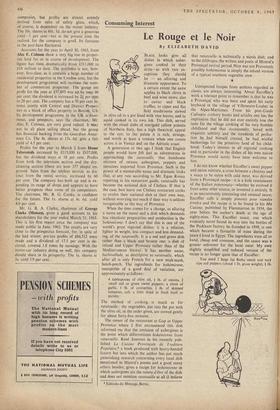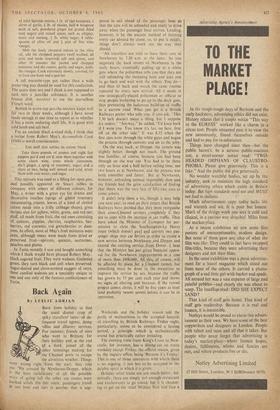Consuming Interest
Le Rouge et le Noir
By ELIZABETH DAVID BLACK looks give all dishes in which auber- gines cooked in their skins—as with rare ex- ceptions they should be — an .alluring and dramatic appearance. To a certain extent the same applies to black olives in beef and wine stews; also to caviar and black truffles; to cepes and flat field mushrooms stewed in olive oil in a pot lined with vine leaves; and to squid cooked in its own ink. This dish, served with the ritual slabs of marigold yellow polenta of Northern Italy, has a high theatrical appeal to the eye; to the palate it is rich, strange, and worth at least a venture when one comes across it in Venice and on the Adriatic coast.
A generation or two ago I think that English people would have felt just as adventurous in approaching the ratatouille, that handsome mixture of onions, aubergines, peppers and tomatoes imported from Provence. Such is the power of a memorable name and dramatic looks that, at any rate according to Mr. Egon Roney reporting in his restaurant guide, ratatouille has become the national dish of Chelsea. If that is the case, best leave our Chelsea restaurant cooks - to evolve their national dish in their own way, without worrying too much if their way is seldom recognisable as the way of Provence.
When the time comes for a change, as alluring a name on the menu and a dish which demands less ritualistic preparation and production is the 7whemienne. I don't say that this is one of the world's great regional dishes; it is a relation, lighter in weight, less compact and less demand- ing, of the ratatouille. It is a red and green dish rather than a black and bronze one; a dish of inland and Upper Provence rather than of the
Mediterranean littoral. It has another name, barbOuillade, as descriptive as ratatouille, which
after all is only French for a stew mish-mash, hotch-potch. The ingredients for bohemienne, susceptible of a good deal of variation, are approximately as follows:
4 tablespoons of olive oil, lb. of onions, 2
small red or green sweet peppers, a clove of
garlic, I lb. of courgettes, lb. of skinned tomatoes, salt, a little dried or fresh basil or parsley.
The method of ' cooking is much as for ratatouille: the vegetables, put into the pot with the olive oil, in the order given, are stewed gently for about forty-five minutes.
The owner of the restaurant at Gap in Upper Provence where I first encountered this dish informed me that the omission of aubergines is the point which differentiates bohemienne from ratatouille. Rene Jouveau in his recently pub- lished La Cuisine Provencale de Tradition Populaire,* a book produced with heavy-handed luxury but into which the author has put much painstaking research concerning every local dish mentioned in Mistral's poems and a good many others besides, gives a recipe for bohemienne in which aubergines are the raison d'être of the dish and does not mention ratatouille at all (I believe
"Editions du Message, Berne.
that ratatouille is technically a nigois dish; and to the felibriges, the writers and poets of Mistral's Provençal revival period, Nice was not Provence); possibly bohemienne is simply the inland version of a typical southern vegetable stew.
Unexpected recipes from authors regarded as classic are always interesting. About Escoffier's work a relevant point to remember is that he was a Provençal who was born and spent his early boyhood in the village of ' Villeneuve-Loubet in the Alpes-Maritimes. From his post-Guide Culinaire cookery books and articles one has the impression that he did not ever entirely lose the taste for the village cooking of his very humble childhood and that occasionally, bored with exquisite subtlety and the standards of perfec- tion he had himself created, he had wistful hankerings for the primitive food of his child- hood. Today's interest in all regional cooking and in particular in the dishes of his own native Provence would surely have been welcome to him.
I do not know whether Escoffier's sweet pepper and onion mixture, a cross between a chutney and a sauce to be eaten with cold meat, was derived from a Provençal recipe—it is a little reminiscent of the Italian peperonata—whet her he evolved it from some other source, or invented it entirely. It is an uncommonly interesting and unusual sauce; Escoffier calls it simply piments pour viandes froides and the recipe is to be found in his Ma Cuisine, published by Flammarion in 1934, the year before the author's death at the age of eighty-nine. This Escoffier sauce, one which. evidently never found its way into the bottles of the Peckham factory he founded in 1898, is one which became a favourite of mine daring the years I lived in Egypt. The ingredients were all to hand, cheap and common, and the sauce was a greater enlivener for the local meat. My own slightly simplified and reduced version of the recipe is no longer quite that of Escoffier: You need 2 large fat fleshy sweet and very ripe red peppers (about" I lb. gross weight), lb. of mild Spanish onions, 1 lb. of ripe tomatoes, 1 clove of garlic, 1 lb. of raisins, half et teaspoon each of salt, powdered ginger (or grated dried root sugar) and mixed spices such as allspice, mace and nutmeg, f lb. white sugar, 4 table-
spoons of olive oil and pint of fine wine vinegar.
Melt the finely chopped onions in the olive oil, add the chopped peppers (well washed, all core and seeds removed) salt and spices, and after 10 minutes the peeled and chopped tomatoes and the raisins, garlic and sugar, lastly the vinegar. Cook extremely slowly, covered, for at least one hour and a quarter.
A tall marmite-type pot rather than a wide preserving pan should be used for this confection. The sauce does not and I think is not supposed to turn into a jam-like substance. It is another bronze dish, mordort to use the marvellous
trench word. . .
Bottled in screw-top jars the mixture keeps well foi' two or three weeks, although I have never Made enough at one time to report as to whether it has a more enduring shelf life. It is good with cold lamb and salt beef.
For an ancient black-a-vised dish, I think that a recipe from Robert May's AccompliAlu Cook (1660) is worth consideration : Tart stuff that carries its colour black
Take three pounds of prunes and eight fair pippins par'd and cord, stew them together with some claret wine, sonic whole cinnamon, slic't ginger, a sprig of rosemary, sugar, and a clove or two, being well stewed and cold, strain them with rose-water, and sugar.
This mixture was used as a filling for open pies, and possibly appeared on Stuart tables in company with others of different colours, for May, a writer with a great eye for drama and decorative touches (sprigs of gilded rosemary Op-lamenting creams, leaves of a kind of clotted cream made into a frilly cabbage shape), gives recipes also for yellow, white, green, and red tart .tuff, all made from fruit, the red ones consisting Of quinces, pippins, cherries, raspberries, bar- berries, red currants, red gooseberries or dam- Sons. In effect, most of May's fruit mixtures were Jams, although many were made from dried or Preserved fruit—apricots, quinces, nectarines, Peaches and plums.
• • In Turin recently I saw and bought something Which [think would have pleased Robert May: 1?lack sugared fruit. They were walnuts. Gathered green, they turn black and soft when preserved. Sugar-dusted and clove-scented nuggets of onyx, these candied walnuts are a speciality unique to one and one only of the famous, confectioners of Turin.











































 Previous page
Previous page